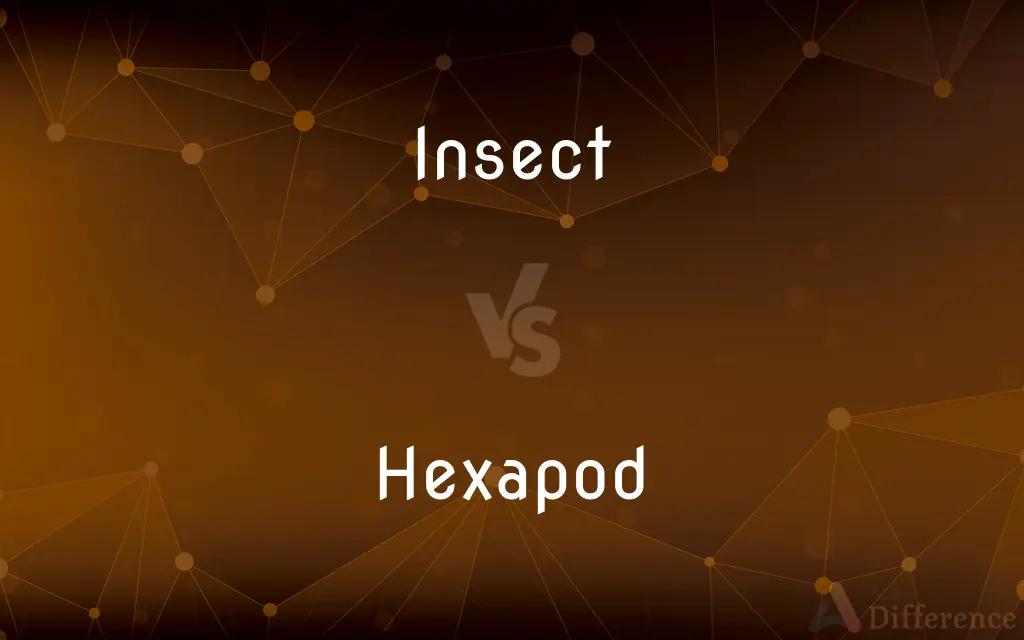Insect vs. Hexapod — What's the Difference?
By Tayyaba Rehman & Fiza Rafique — Updated on March 28, 2024
Insects are a class of arthropods characterized by a three-part body, three pairs of legs, and typically one or two pairs of wings. Hexapods include all six-legged arthropods, making insects a subset of hexapods.

Difference Between Insect and Hexapod
Table of Contents
ADVERTISEMENT
Key Differences
Insects, belonging to the class Insecta, are defined by specific morphological features: a segmented body divided into head, thorax, and abdomen; three pairs of jointed legs; compound eyes; and one pair of antennae. They often have wings, with the group encompassing a vast range of species, including beetles, butterflies, and ants. On the other hand, hexapods encompass all organisms with six legs, including insects and closely related groups like Collembola (springtails), which are not considered true insects.
While all insects are hexapods due to their six-legged structure, not all hexapods are insects. This distinction highlights the broader classification of hexapods, which includes insects as well as other six-legged creatures that do not fit the narrower criteria for insects. For example, springtails are hexapods but lack the distinctive body segmentation and wings of insects.
The term "insect" is used more commonly in everyday language and refers to a well-defined group of animals known for their ecological roles as pollinators, decomposers, and a vital part of the food web. In contrast, "hexapod" is a term more frequently used in scientific contexts to refer to the larger classification that includes insects and their relatives, emphasizing the diversity of six-legged arthropods beyond the traditional insect classification.
In terms of evolution and taxonomy, insects represent a highly successful and diverse lineage within the hexapods, showcasing a wide range of adaptations to different environments. Hexapods as a whole illustrate the evolutionary branching that occurred early in the arthropod lineage, leading to the development of various six-legged organisms, not all of which have pursued the same evolutionary path as insects.
Despite these differences, both insects and non-insect hexapods play crucial roles in their ecosystems. Insects are known for their roles in pollination, as predators of pests, and as food for other animals. Non-insect hexapods, though less visible and often less well understood, contribute to soil health, the breakdown of organic matter, and the overall balance of ecosystems they inhabit.
ADVERTISEMENT
Comparison Chart
Definition
Arthropods with a three-part body and three pairs of legs.
All six-legged arthropods, including insects.
Classification
Class Insecta within the phylum Arthropoda.
A broader grouping that includes Class Insecta and others.
Body Structure
Divided into head, thorax, abdomen; usually have wings.
Six legs, but body structure can vary.
Examples
Bees, ants, butterflies.
Includes all insects plus organisms like springtails.
Wings
One or two pairs of wings (except in some species).
Wings are exclusive to insects within hexapods.
Compare with Definitions
Insect
A small arthropod animal with a distinct body segmentation.
The honeybee is an insect important for pollination.
Hexapod
An organism with six legs, including insects and related groups.
Springtails, while not insects, are hexapods.
Insect
Insects often have wings and antennae.
Butterflies are known for their colorful wings.
Hexapod
Not all hexapods have wings; this trait distinguishes insects.
Wingless hexapods include many soil dwellers.
Insect
They play key roles in ecosystems, such as pollinators and decomposers.
Beetles help decompose dead wood.
Hexapod
The term is more common in scientific discussions.
Biologists study hexapod diversity in ecosystems.
Insect
Insects are the most diverse group of organisms on Earth.
There are more species of ants than mammals.
Hexapod
Hexapods have a variety of body plans and lifestyles.
Some hexapods are adapted to life in soil.
Insect
Found in nearly all environments from rivers to deserts.
Dragonflies thrive near water bodies.
Hexapod
Reflects a broader classification than insects.
Research on hexapods covers both insects and non-insect groups.
Insect
Insects or Insecta (from Latin insectum) are pancrustacean hexapod invertebrates and the largest group within the arthropod phylum. Insects have a chitinous exoskeleton, a three-part body (head, thorax and abdomen), three pairs of jointed legs, compound eyes and one pair of antennae.
Hexapod
Any of numerous six-legged arthropods of the subphylum Hexapoda, which includes the insects and several groups formerly classified as insects, such as the springtails.
Insect
A small arthropod animal that has six legs and generally one or two pairs of wings
Insect pests
Hexapod
Of or belonging to the subphylum Hexapoda.
Insect
Any of numerous arthropod animals of the class Insecta, having an adult stage characterized by three pairs of legs and a body segmented into head, thorax, and abdomen and usually having one or two pairs of wings. Insects include the flies, crickets, mosquitoes, beetles, butterflies, and bees.
Hexapod
Having six legs or feet.
Insect
Any of various other small, chiefly arthropod animals, such as spiders, centipedes, or ticks, usually having many legs. Not in scientific use.
Hexapod
Any organism, being or robot with six legs.
Insect
An insignificant or contemptible person.
Hexapod
An arthropod with six feet; a member of subphylum Hexapoda.
Insect
An arthropod (in the Insecta class) characterized by six legs, up to four wings, and a chitinous exoskeleton.
Our shed has several insect infestions, including ants, yellowjackets, and wasps.
Hexapod
(dated) An insect.
Insect
(colloquial) Any small arthropod similar to an insect, including spiders, centipedes, millipedes, etc.
The swamp is swarming with every sort of insect.
Hexapod
Having six feet, six-footed; belonging to the subphylum Hexapoda; hexapodous.
Insect
(derogatory) A contemptible or powerless person.
The manager’s assistant was the worst sort of insect.
Hexapod
Having six feet.
Insect
One of the Insecta; esp., one of the Hexapoda. See Insecta.
Insect
Any air-breathing arthropod, as a spider or scorpion.
Insect
Any small crustacean. In a wider sense, the word is often loosely applied to various small invertebrates.
Insect
Fig.: Any small, trivial, or contemptible person or thing.
Insect
Of or pertaining to an insect or insects.
Insect
Like an insect; small; mean; ephemeral.
Insect
Small air-breathing arthropod
Insect
A person who has a nasty or unethical character undeserving of respect
Common Curiosities
What distinguishes an insect from other hexapods?
Insects are distinguished by their specific body segmentation into head, thorax, and abdomen, and often by the presence of wings, unlike other hexapods.
What is a hexapod?
A hexapod is any organism within a broader classification that includes all six-legged arthropods, encompassing insects and related groups.
Why are insects important?
Insects play critical roles in ecosystems as pollinators, decomposers, and as a food source for other animals.
Can hexapods live in water?
Yes, some hexapods, including certain insects, are adapted to aquatic life.
What are some examples of non-insect hexapods?
Examples include Collembola (springtails) and Protura, which are not classified as insects.
Are all insects hexapods?
Yes, all insects are hexapods because they have six legs.
Are all hexapods insects?
No, not all hexapods are insects; the group also includes non-insect organisms like springtails.
What is an insect?
An insect is a small, six-legged arthropod with a body divided into three parts: head, thorax, and abdomen, often having wings and antennae.
Are hexapods found in urban areas?
Yes, hexapods, including many insects, are adaptable and can be found in urban environments.
What are the evolutionary origins of hexapods?
Hexapods evolved from early arthropods, with insects and related groups diversifying over millions of years.
Do all insects have wings?
Most insects have wings at some stage of their life cycle, but there are wingless species as well.
What is the difference in the classification of insects and hexapods?
Insects are classified under the class Insecta, while hexapods include insects and other related six-legged groups in a broader classification.
How are hexapods classified within the animal kingdom?
Hexapods are classified within the phylum Arthropoda, showcasing their shared characteristics and evolutionary background with other arthropods.
How do scientists study hexapods?
Scientists study hexapods through field observation, laboratory experiments, and ecological modeling to understand their diversity, behavior, and roles in ecosystems.
How do hexapods contribute to the environment?
Both insects and non-insect hexapods contribute to soil health, nutrient cycling, and serve as key components in food webs.
Share Your Discovery

Previous Comparison
Paxil vs. Zoloft
Next Comparison
Chibi vs. KawaiiAuthor Spotlight
Written by
Tayyaba RehmanTayyaba Rehman is a distinguished writer, currently serving as a primary contributor to askdifference.com. As a researcher in semantics and etymology, Tayyaba's passion for the complexity of languages and their distinctions has found a perfect home on the platform. Tayyaba delves into the intricacies of language, distinguishing between commonly confused words and phrases, thereby providing clarity for readers worldwide.
Co-written by
Fiza RafiqueFiza Rafique is a skilled content writer at AskDifference.com, where she meticulously refines and enhances written pieces. Drawing from her vast editorial expertise, Fiza ensures clarity, accuracy, and precision in every article. Passionate about language, she continually seeks to elevate the quality of content for readers worldwide.
















































